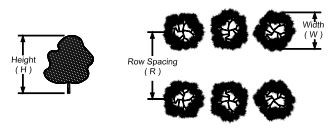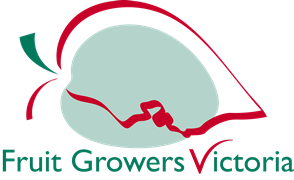International Article: Nova Scotia, Environmental Farm Plan Program, Fact Sheet
Most pesticide recommendations for orchards are given at a specific rate per hectare. This rate is determined for a 'standard' orchard, in which trees are 4.8 m high, 5.5 m wide, and 7.4 m between rows: such an orchard has a volume of 35 676 m3 of foliage. A dilute application in a 'standard' orchard is approximately 3343 L/ha.
However, as producers move towards medium to high density plantings of dwarf or semi-dwarf stock, standard orchards are becoming less common. As a result, growers may be applying more water and pesticide than necessary, because their orchards have a smaller volume of foliage than a 'standard' orchard. The use of Tree-Row-Volume (TRV) calculations to determine foliage volume and subsequently the amount of chemical that should be applied to a given orchard may substantially reduce the amount, and cost of pesticides used in orchards.
TRV should be calculated and recorded for each orchard block. In blocks of growing trees, calculating the TRV every year will give the most accurate indication of foliage volume. This information can then be used to adjust the amount of water and pesticide required. Once trees have attained their maximum growth, TRV calculations may only need to be done once every few years.
- Data required for TRV calculation - The following information is necessary to perform TRV calculations:
- Physical measurements (in meters) of trees in each uniform orchard block (Fig.1). tree height (h) tree width (w) distance between row centres (r)
- Orchard block size in hectares (block must be of uniform age and design)
- Canopy density (dense=1, moderately well pruned=0.85, very open-0.75)
- Chemical information: label rate per hectare of chemical to be used; desired concentration rate (3x, 15x); cost of chemical per unit
- Sprayer tank volume (in litres)

Figure 1. Measurement data (in meters) required for TRV calculation (h=tree height, r=distance between rows, w=canopy width).
Carefully collect your information as inaccurate data in your calculations will give erroneous results.
TRV Calculations
Once you have obtained your orchard measurements and other information, you are ready to do the TRV calculations. Simply substitute your actual measurements for the variables in the following formulas and solve for TRV and percent of standard TRV.
TRV = m /ha = (h) x (w) x (10,000 m /r) 3 % of standard TRV = (TRV/35,676m) x 100
The result can now be used in several other simple calculations to better match chemical use to orchard situation, improving the efficiency of your pest management program.
Application of TRV
Use TRV values and the other information you have collected, to complete the calculations in Table 1. These calculations are used to relate the volume of foliage to the amount of chemical that will need to be applied. In most cases, sprayers will have to be re-calibrated to accommodate required adjustments to a pest management program utilizing TRV measurements.
TRV Worksheet
A worksheet for the manual calculation of TRV and its application has been provided. This sheet may be copied so that a separate record is kept for each orchard/chemical combination. Place these sheets in a binder for future reference.
TRV Limitations
Remember that the TRV serves as a guide only, and that as tree density increases (with the growth of suckers and leaves), it may be necessary to increase the volume of water and chemical to get adequate coverage. Increased pest pressure, and past experience, may also influence the actual amount of chemical applied. Note that accurate calculation of TRV will not compensate for poor coverage, timing, choice of chemical, weather, etc. TRV is designed to ensure that the grower is not applying more chemical than is needed to achieve acceptable pest control.
Table 1. Calculations to determine impact of TRV on pest management program.
-----------------------------------------------------------------------------------------------------------------------------
1) TRV chemical rate (L/ha) = chemical label rate (L/ha) x (% of ‘standard’ TRV)
2) TRV dilute water volume (L/ha) = (3343 L/ha) x (% ‘standard’ TRV) x (canopy density)
3) Water volume for concentrate application (L/ha) = TRV dilute water volume (L/ha) / Desired concentration rate
4) Hectares/tank = tank volume (L) / water volume for concentrate application (L/ha)
5) Chemical per tank = Hectares/tank x TRV chemical rate (L/ha)
Disclaimer: The information contained in this publication is based on knowledge and understanding at the time of writing. However, while all reasonable efforts have been made to ensure that this information is correct and current, the information covered is subject to change. Fruit Growers Victoria Limited does not assume responsibility and hereby disclaims any express or implied liability whatsoever to any party for any loss or damage caused by errors or omissions, whether these errors or omissions result from negligence, accident or any other cause.

